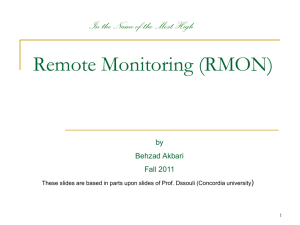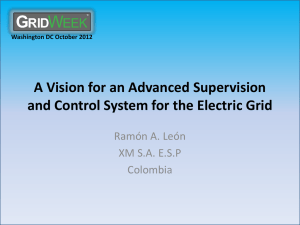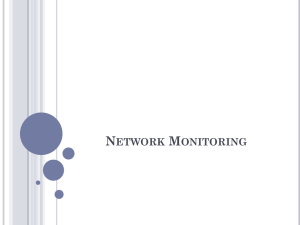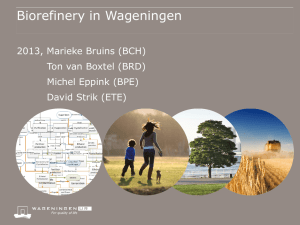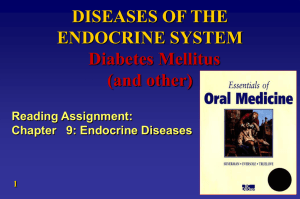Chapter 8
advertisement
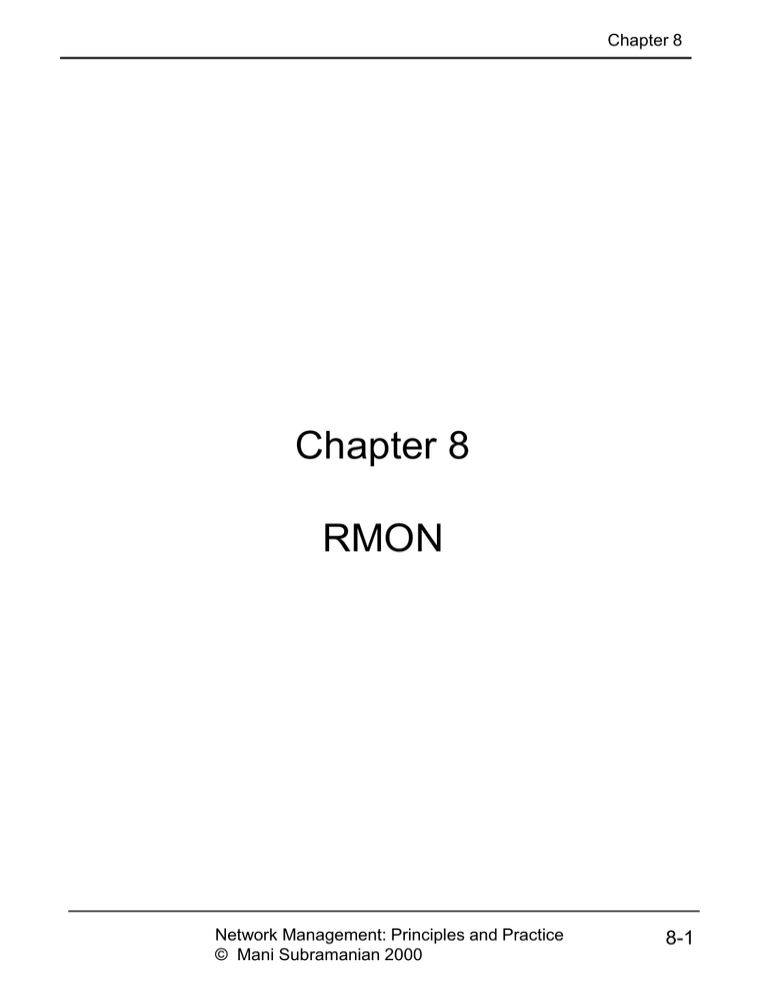
Chapter 8 Chapter 8 RMON Network Management: Principles and Practice © Mani Subramanian 2000 8-1 Chapter 8 RMON Components D a ta A n a ly z e r SNMP T ra ffic R o u te r BACKBONE NETW ORK R o u te r SNMP T ra ffic RMON P ro b e LAN • RMON Probe • Data gatherer - a physical device • Data analyzer • Processor that analyzes data Notes • RMON Remote Network Monitoring Network Management: Principles and Practice © Mani Subramanian 2000 8-2 Chapter 8 Network with RMONs R e m o te F D D I L A N F D D I P ro b e R o u te r w ith R MON FDDI B a c k b o n e N e tw o rk R o u te r B rid g e Local LA N R o u te r N MS R e m o te T o k e n R in g L A N E th e rn e t P ro b e T o ke n R in g P ro b e F ig u re 8 .1 N e tw o rk C o n fig u ra tio n w ith R M O N s Notes Nots • Note that RMON is embedded monitoring remote FDDI LAN • Analysis done in NMS Network Management: Principles and Practice © Mani Subramanian 2000 8-3 Chapter 8 RMON Benefits • Monitors and analyzes locally and relays data; Less load on the network • Needs no direct visibility by NMS; More reliable information • Permits monitoring on a more frequent basis and hence faster fault diagnosis • Increases productivity for administrators Notes Network Management: Principles and Practice © Mani Subramanian 2000 8-4 Chapter 8 RMON MIB rm o n (m ib -2 1 6 ) rm o n C o n fo rm a n c e (2 0 ) s ta tis tic s (1 ) p ro b e C o n fig (1 9 ) h is to ry (2 ) u s rH is to ry (1 8 ) a 1 M a trix (1 7 ) a la rm (3 ) a 1 H o s t (1 6 ) h o s t (4 ) n 1 M a trix (1 5 ) h o s tT o p N (5 ) m a trix (6 ) n 1 H o s t (1 4 ) filte r (7 ) a d d re s s M a p (1 3 ) c a p tu re (8 ) p ro to c o lD is t (1 2 ) e v e n t (9 ) p ro to c o lD ir (1 1 ) RMON2 RMON1 T o k e n R in g (1 0 ) R M O N 1 E x te n s io n F ig u re 8 .2 R M O N G ro u p Notes • RMON1: Ethernet RMON groups (rmon 1 - rmon 9) • RMON1: Extension: Token ring extension (rmon 10) • RMON2: Higher layers (3-7) groups (rmon 11 - rmon 20) Network Management: Principles and Practice © Mani Subramanian 2000 8-5 Chapter 8 Row Creation & Deletion S ta te va lid cre a te R e qu e st u n d e rC re a tio n in valid Enumera tio n 1 2 3 4 D e scrip tio n R o w e xists a n d is a ctive . It is fully co n fig u re d a nd o p era tio n al C re a te a n e w ro w b y cre a tin g this ob je ct R o w is n o t fully a ctive D e le te th e ro w b y d isa sso cia tin g the m a p p in g o f this e n try • EntryStatus data type introduced in RMON • EntryStatus (similar to RowStatus in SNMPv2) used to create and delete conceptual row. • Only 4 states in RMON compared to 6 in SNMPv2 Notes Network Management: Principles and Practice © Mani Subramanian 2000 8-6 Chapter 8 RMON Groups and Functions T o k e n R in g S ta tis tic s T o k e n R in g S ta tis tic s T o k e n R in g H is to ry H is to ry C o n tro l E th e rn e t H is to ry H is to ry C o n tro l E th e rn e t S ta tis tic s E th e rn e t S ta tis tic s R e m o te ly M o n ito re d N e tw o rk H o s t a n d C o n v e rs a tio n S ta tis tic s D a ta G a th e rin g H ost S ta tis tic s H o s tT o p N S ta tis tic s M a trix S ta tis tic s N e tw o rk M anager F ilte r G ro u p Packet F ilte rin g C hannel F ilte rin g A la rm G e n e ra tio n Event G e n e ra tio n Packet C a p tu re F ig u re 8 .3 R M O N 1 G ro u p s a n d F u n c tio n s Notes • Probe gathers data • Functions • Statistics on Ethernet, token ring, and hosts / conversations • Filter group filters data prior to capture of data • Generation of alarms and events Network Management: Principles and Practice © Mani Subramanian 2000 8-7 Chapter 8 RMON1 MIB Groups & Tables G ro u p S ta tistics O ID rm o n 1 F u n ctio n L in k le vel sta tistics H isto ry rm o n 2 P e rio dic sta tistical d ata co lle ction a n d sto ra ge fo r la te r re trie val A la rm rm o n 3 H o st rm o n 4 G e n e ra te s e ve n ts w h e n the d a ta sa m p le g a th e red cro sse s p ree sta blish e d th re sh old s G a th e rs sta tistical d a ta o n ho sts H o stT o p N rm o n 5 M a trix rm o n 6 F ilte r rm o n 7 F ilte r fun ctio n tha t e n ab le s ca p tu re o f d e sire d p ara m e te rs P a cke t C a p tu re rm o n 8 E ve n t rm o n 9 T o ke n R in g rm o n 1 0 P a cke t ca p tu re ca p a bility to g a th e r p a cke ts a fte r th e y flo w th ro u g h a ch a nn el C o n trols th e g e n era tio n o f e ve n ts a n d n o tifica tion s S e e T a ble 8.3 C o m p u te s th e to p N h o sts on th e re spe ctive ca teg o rie s o f sta tistics g a th ere d S ta tistics o n tra ffic b e tw e e n p air o f h o sts T a ble s -e th e rS ta tsT a ble -e th e rS ta ts2 T ab le -h isto ryC o ntrolT a ble -e th e rH isto ryT a ble -h isto ryC o ntrol2T a ble -e th e rH isto ry2T a ble -a la rm T a b le -h o stC o n trolT ab le -h o stT a ble -h o stT im e T a ble -h o stC o n trol2 T a ble -h o stT o p N co n trolT a ble -m a trixC o n tro lT a ble -m a trixS D T a b le -m a trixD S T a b le -m a trixC o n tro l2T a ble -filte rT a ble -ch a n n elT a ble -filte r2T a ble -ch a n n el2T a ble -b u fferco n tro lT a ble -ca p tu re B u ffe rT a ble -e ve n tT a ble S e e T a ble 8.3 Notes • Ten groups divided into three categories • Statistics groups (rmon 1, 2, 4, 5, 6, and 10)) • Event reporting groups (rmon 3 and 9) • Filter and packet capture groups(romon 7 and 8) • Groups with “2” in the name are enhancements with RMON2 Network Management: Principles and Practice © Mani Subramanian 2000 8-8 Chapter 8 Textual Convention: LastCreateTime and TimeFilter • LastCreateTime tracks change of data with the changes in control in the control tables • Timefilter used to download only those rows that changed after a particular time FooTable (bold indicating the indices): fooTimeMark fooIndex fooCounts fo o C o u n ts.0 .1 fo o C o u n ts.0 .2 fo o C o u n ts.1 .1 fo o C o u n ts.1 .2 fo o C o u n ts.2 .1 fo o C o u n ts.1 .2 fo o C o u n ts.3 .1 fo o C o u n ts.3 .2 fo o C o u n ts.4 .2 5 9 5 9 5 9 5 9 9 -- (N o te th a t ro w # 1 d o e s n o t e xis t fo r tim e s 4 & 5 sin c e th e la st u p d a te o c cu rre d a t tim e -m a rk 3 .) fo o C o u n ts.5 .2 9 (B o th ro w s # 1 a n d # 2 d o n o t e xist fo r tim e -m a rk g re a te r th a n 5 .) Notes • Bold objects (fooTimeMark and fooIndex) are indices Network Management: Principles and Practice © Mani Subramanian 2000 8-9 Chapter 8 Control and Data Tables d a ta T a b le d a ta E n try co n tro lT a b le co n tro lE n try c o n tro l In d e x co n tro l D a ta S o u rce co n tro l T a b le S ize co n tro l Ow ner co n tro l S ta tu s co n tro l O th e r c o n tro l In d e x co n tro l D a ta S o u rce co n tro l T a b le S ize co n tro l Ow ner co n tro l S ta tu s co n tro l O th e r d a ta In d e x d a ta A d d lIn d e x d a ta O th e r d a ta In d e x d a ta A d d lIn d e x d a ta O th e r d a ta In d e x d a ta A d d lIn d e x d a ta O th e r d a ta In d e x d a ta A d d lIn d e x d a ta O th e r N o te o n In d ic e s : In d ic e s m a rk e d in b o ld le tte r V a lu e o f d a ta In d e x s a m e a s v a lu e o f c o n tro lIn d e x F ig u r e 8 .4 R e la tio n s h ip b e tw e e n C o n tr o l a n d D a ta T a b le s Notes • Control table used to set the instances of data rows in the data table • Values of data index and control index are the same Network Management: Principles and Practice © Mani Subramanian 2000 8-10 Chapter 8 Matrix Control and SD Tables m a trixS D T a b le m a trixS D E n try m a trixC o n tro lT ab le m a trixC o n tro lE n try m atrix C o n tro l In d e x = 1 m atrix C o n tro l In d e x = 2 m a trix C o n tro l D a taS o urce = ifIn diex.1 m a trix C o n tro l D a taS o urce = ifIn diex.2 m a trix C o n tro l T a ble S ize = 10 m a trix C o n tro l O w n er = " B ob " m a trix C o n tro l T a ble S ize = 10 m a trix C o n tro l O w n er = " B ob " m a trix C o n tro l S ta tu s = 1 m a trix C o n tro lL a st D e leteT im e = 1 00 0 m a trix C o n tro l S ta tu s = 1 m a trix C o n tro lL a st D e leteT im e = 1 00 0 50 N o te o n In d ic e s : In d ic e s m a rk e d in b o ld le tte r V a lu e o f d a ta In d e x s a m e a s v a lu e o f c o n tro lIn d e x m atrixS D So u rc e A d d re ss = 1 72 .1 5 .8 .1 1 m atrixS D D es tin a tio n A d d re ss = 1 92 .7 .8 .11 m atrix SD In d e x = 1 m a trix SD P kts = m atrixS D So u rc e A d d re ss = 1 72 .1 5 .8 .1 1 m atrixS D D es tin a tio n A d d re ss = 1 99 .5 .8 .20 m atrix SD In d e x = 1 m a trix SD P kts = m atrixS D So u rc e A d d re ss = 1 72 .1 6 .8 .1 6 m atrixS D D es tin a tio n A d d re ss = 1 93 .5 .8 .20 m atrix SD In d e x = 2 m a trix SD P kts = m atrixS D So u rc e A d d re ss = 1 72 .1 6 .8 .2 0 m atrixS D D es tin a tio n A d d re ss = 1 93 .5 .8 .20 m atrix SD In d e x = 2 m a trix SD P kts = F ig u r e 8 .4 R e la tio n s h ip b e tw e e n C o n tr o l a n d D a ta T a b le s Notes • matrixSDTable is the source-destination table • controlDataSource identifies the source of the data • controlTableSize identifies entries associated with the data source • controlOwner is creator of the entry Network Management: Principles and Practice © Mani Subramanian 2000 8-11 Chapter 8 Host Top N Group Example H o stT o p N Host 1 Host 2 Host 3 Host 4 Host 5 Host 6 Host 7 Host 8 Host 9 Host 10 0 100 200 300 400 G ig a O c t e t s F ig u re 8 .5 H o s tT o p -1 0 O u tp u t O c te ts Notes Network Management: Principles and Practice © Mani Subramanian 2000 8-12 Chapter 8 Filter Group filte rT a ble filte rE ntry ch an ne lT ab le ch an ne lE n try c ha nne l Index =1 c ha nne l Index = 2 ch an ne l IfIn d ex = 1 ch an ne l IfIn d ex ch an ne l A ccep tT ype ch an ne l A ccep tT ype ch an ne l D a taC on trol O th er C h a nn e l P aram e te rs ch an ne l D a taC on trol O th er C h a nn e l P aram e te rs N o te o n In d ic e s : In d ic e s m a rk e d in b o ld le tte r V a lu e o f filte rC h a n n e lIn d e x s a m e a s v a lu e o f c h a n n e lIn d e x filte rInde x =1 filte r C h a nn e lInd ex =1 F ilter P aram e te rs filte rInde x =2 filte r C h a nn e lInd ex =1 F ilter P aram e te rs filte rInde x =3 filte r C h a nn e lInd ex =2 F ilter P aram e te rs filte rInde x =4 filte r C h a nn e lInd ex =2 F ilter P aram e te rs Notes • Filter group used to capture packets defined by logical expressions • Channel is a stream of data captured based on a logical expression • Filter table allows packets to be filtered with an arbitrary filter expression • A row in the channel table associated with multiple rows in the filter table Network Management: Principles and Practice © Mani Subramanian 2000 8-13 Chapter 8 Packet Capture Group Channel Table Filter Table (many for each channel) Capture Buffer Table (One entry per Channel) Notes • Packet capture group is a post-filter group • Buffer control table used to select channels • Captured data stored in the capture buffer table Network Management: Principles and Practice © Mani Subramanian 2000 8-14 Chapter 8 RMON TR Extension Groups T o k e n R in g G ro u p S ta tis tic s P ro m is c u o u s S ta tis tic s M a c -L a y e r H is to ry P ro m is c u o u s H is to ry R in g S ta tio n R in g S ta tio n O rd e r R in g S ta tio n C o n fig u ra tio n S o u rc e R o u tin g F u n c tio n C u rre n t u tiliza tio n a n d e rro r s ta tis tic s of M ac Layer C u rre n t u tiliza tio n a n d e rro r s ta tis tic s o f p ro m is c u o u s d a ta H is to rica l u tiliz a tio n a n d e rro r s ta tis tic s o f M ac Layer H is to rica l u tiliz a tio n a n d e rro r s ta tis tic s o f p ro m is c u o u s d a ta S ta tio n sta tis tic s O rd e r o f th e s ta tio n s A c tiv e c o n fig u ra tio n o f rin g s ta tio n s U tiliz a tio n sta tis tic s o f s o u rc e ro u tin g in fo rm a tio n T a b le s to k e n R in g M L S ta ts T a b le to k e n R in g M L S ta ts 2 T a b le to k e n R in g P S ta ts T a b le to k e n R in g P S ta ts 2 T a b le to k e n R in g M L H is to ry T a b le to k e n R in g P H is to ry T a b le rin g S ta tio n C o n tro lT a b le rin g S ta tio n T a b le rin g S ta tio n C o n tro l2 T a b le rin g S ta tio n O rd e rT a b le rin g S ta tio n C o n fig C o n tro lT a b le rin g S ta tio n C o n fig T a b le s o u rc e R o u tin g S ta ts T a b le s o u rc e R o u tin g S ta ts 2 T a b le Notes • Two statistics groups and associated history groups • MAC layer (Statistics group) collects TR parameters • Promiscuous Statistics group collects packets promiscuously on sizes and types of packets • Three groups associated with the stations • Routing group gathers on routing Network Management: Principles and Practice © Mani Subramanian 2000 8-15 Chapter 8 RMON2 • Applicable to Layers 3 and above • Functions similar to RMON1 • Enhancement to RMON1 • Defined conformance and compliance Notes Network Management: Principles and Practice © Mani Subramanian 2000 8-16 Chapter 8 RMON2 MIB T a b le 8 .4 R M O N 2 M IB G ro u p s a n d T a b les G ro u p P ro to col D ire cto ry P ro to col D istribu tio n A d d re ss M a p O ID rm o n 1 1 F u n c tio n In ve n to ry o f p ro to cols T a b les p ro to colD irT a ble rm o n 1 2 p ro to colD istC o n trolT a ble p ro to colD istS ta tsT a ble a d d re ssM a p C o n trolT ab le a d d re ssM a p T a ble N e tw o rk L a ye r H o st N e tw o rk L a ye r M a trix rm o n 1 4 R e la tive sta tistics o n o cte ts a n d p a cke ts M a c a d d re ss to n e tw o rk a d d re ss o n th e in te rfa ce s T ra ffic da ta fro m a n d to e a ch ho st T ra ffic da ta fro m e a ch p a ir o f ho sts A p p lica tio n L a ye r H o st rm o n 1 6 A p p lica tio n L a ye r M a trix rm o n 1 7 U se r H isto ry C o lle ctio n rm o n 1 8 P ro b e C o n figu ra tion rm o n 1 9 RMON C o n fo rm a n ce rm o n 2 0 rm o n 1 3 rm o n 1 5 T ra ffic da ta b y p ro to col fro m a n d to e a ch h o st T ra ffic da ta b y p ro to col be tw e e n p a irs o f ho sts U se r-sp e cifie d h istorical d a ta o n a larm s a n d sta tistics C o n figu ra tion o f pro b e p a ra m e te rs R M O N 2 M IB C o m p lia n ce s an d C o m p lia n ce G ro u p s n 1 H o stC o n tro lT a ble n 1 H o stT a ble n 1 M a trixC o n trolT a ble n 1 M a trixS D T a ble n 1 M a trixD S T a ble n 1 M a trixT o p N C o n trolT a ble n 1 M a trixT o p N T a ble a 1 H o stT a ble a 1 M a trixS D T a ble a 1 M a trixD S T a ble a 1 M a trixT o p N C o n trolT a ble a 1 M a trixT o p N T a ble u srH isto ryC o n trolT a ble u srH isto ryO b je ctT a ble u srH isto ryT a ble se rialC o n fig T a ble n e tC o n fig T a ble tra p D e stT a ble se rialC o n n e ction T a ble S e e S e ctio n 8 .4 .2 Notes Network Management: Principles and Practice © Mani Subramanian 2000 8-17 Chapter 8 ATM RMON A pp lica tion L aye r U p p e r L a y e r P ro to c o ls R M O N -2 (R F C 2 0 2 1 , 2 0 7 4 ) E th e rn e t RMON (R F C 1 7 5 7 ) T o k e n R in g RMON (R F C 1 5 1 3 ) IE T F M IB s N e tw o rk L a yer 'B ase ' L a yer A T M P ro to c o l ID s fo r R M O N -2 (A d d itio n s to R F C 2 0 7 4 ) S w itc h E x te n s io n s fo r R M O N ATM RMON A d d itio n a l M IB s F ig u re 8 .7 R M O N M IB F ra m e w o rk (© 1 9 9 5 A T M F o ru m ) Notes • ATM Forum extended RMON to ATM • Switch extensions and ATM RMON define objects at the base layer • ATM protocol IDs for RMON2 define additional objects at the higher levels • ATM devices require cell-based measurements and statistics • Probe should be able to handle high speed Network Management: Principles and Practice © Mani Subramanian 2000 8-18 Chapter 8 ATM Probe Location ATM S w itc h ATM S w itc h RMON P ro b e RMON P ro b e (a ) E x te rn a l P ro b e w ith c o p y A T M S w itc h w ith in te rn a l R M O N P ro b e (b ) In te rn a l P ro b e w ith c o p y ATM S w itc h ATM S w itc h RMON P ro b e (c ) In te rn a l P ro b e w ith o u t c o p y (d ) E x te rn a l P ro b e w ith o u t c o p y F ig u re 8 .8 A T M P ro b e L o c a tio n © 1 9 9 5 A T M F o ru m ) Notes • Stand-alone probe in (a) copies the cells • Embedded version in (b) reports data, but has no access to switch fabric • Internal probe (c) similar to (b) with access to switch • Stand-alone probe (d) taps network-to-network interface between two ATM switches • (a) and (b) require duplex circuits, steering of traffic, and design modification • Embedded designs (c) and (d) require no modification Network Management: Principles and Practice © Mani Subramanian 2000 8-19 Chapter 8 ATM RMON MIB Groups T a b le 8 .6 AT M R M O N M IB G ro u p s a n d T ab le s G ro u p O ID p o rtS ele ct a tm R m o n M IB O b je cts 1 a tm S ta ts a tm R m o n M IB O b je cts 2 a tm H o st a tm R m o n M IB O b je cts 3 a tm M a trix a tm R m o n M IB O b je cts 4 F u n c tio n P o rt S e le ctio n B a sic S ta tistics A T M p e r-h o st sta tistics A T M p e r-circuit sta tistics T a b les p o rtS elG rpT a ble p o rtS elT a ble a tm S ta tsC o n trolT a ble a tm S ta tsT a b le a tm H o stC o n tro lT ab le a tm H o stT a b le a tm M a trixC o n tro lT a ble a tm M a trixS D T a b le a tm M a trixD S T a b le a tm M a trixT o p N C o n trolT a ble a tm M a trixT o p N T a ble Notes • ATM RMON MIB contains four groups • portSelect group selects ports • atmStats collects basic statistics based on port selection • atmHost gathers statistics based on host traffic • atmMatrix group collects conversation traffic and ranks the top-N entries Network Management: Principles and Practice © Mani Subramanian 2000 8-20 Chapter 8 A Case Study • A study at Georgia Tech on Internet traffic • Objectives • Traffic growth and trend • Traffic patterns • Network comprising Ethernet and FDDI LANs • Tools used • HP Netmetrix protocol analyzer • Special high-speed TCP dump tool for FDDI LAN • RMON groups utilized • Host top-n • Matrix group • Filter group • Packet capture group (for application level protocols) Notes Network Management: Principles and Practice © Mani Subramanian 2000 8-21 Chapter 8 Case Study Results 1. G ro w th R ate : Internet traffic grew at a significant rate from F ebruary to June at a m onthly rate of 9% to 18% . 12% F ebruary to M arch 9% M arch to A pril 18% A pril to M ay N ote: There is sudden drop in June due to end of spring quarter and sum m er quarter starting. 2. T raffic P attern: M o nthly / W eekly: O nly discernible variation is lower traffic over weekends D aily: 2/3 of the top 5% peaks occur in the afternoons U sers: T op six dom ain of users (96% ) are 20% D om ain 1 30% D om ain 2 S ubdom ain 1 (25% ) S ubdom ain 2 (3% ) 34% D om ain 3 7% D om ain 4 3% D om ain 5 2% D om ain 6 T op three hosts sending or receiving data N ewsgroups M bone Linux host W hat w e have learned : 1. T he three top groups of users contributing to 84% of the Internet traffic are students (surprise!). N ewsgroup services, and D om ain 1. 2. G rowth rate of Internet during the study period in spring quarter is 50% . Network Management: Principles and Practice © Mani Subramanian 2000 8-22
